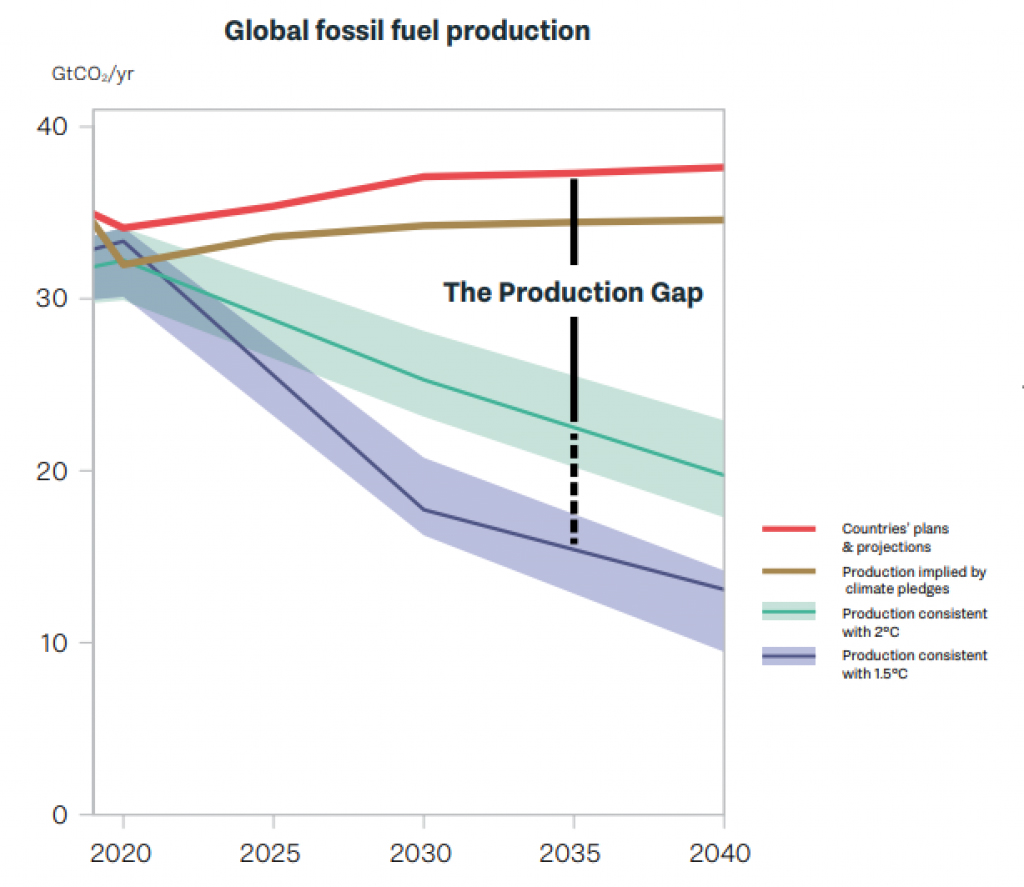Biodiversity & Environment
UNEP Production Gap Report
- 21 Oct 2021
- 4 min read
Why in News
Recently, the 2021 Production Gap Report was released by the leading research institutes and the United Nations Environment Programme (UNEP).
- The Production Gap Report, first launched in 2019, tracks the discrepancy between governments’ planned fossil fuel production and global production levels consistent with limiting warming to 1.5°C or 2°C.
- UNEP’s Major Reports: Emission Gap Report, Adaptation Gap Report, Global Environment Outlook, Making Peace with Nature.
Key Points
- Findings of the Report:
- Increase in Production Gap:
- The production gap to achieve the climate goal is the widest for coal: Production plans and projections by governments would lead to around 240% more coal, 57% more oil, and 71% more gas in 2030 than global levels consistent with limiting warming to 1.5°C.
- The most worrying factor is that almost all major coal, oil and gas producers are planning to increase their production till at least 2030 or beyond.
- Effects of Covid-19:
- The production gap has been fuelled by incremental capital flow towards fossil fuels in comparison to clean energy in the post novel coronavirus disease (Covid-19) recovery phase.
- The Group of 20 countries (G20) has channelised USD300 billion to fossil fuels since the beginning of the pandemic, and the sector is still enjoying significant fiscal incentives.
- The production gap has been fuelled by incremental capital flow towards fossil fuels in comparison to clean energy in the post novel coronavirus disease (Covid-19) recovery phase.
- Increase in Production Gap:
- India’s Position:
- India’s first NDC (Nationally Determined Contribution), issued in 2016, pledged a 33%-35% reduction in the “emissions intensity” of its economy by 2030, compared to 2005 levels.
- The report quotes a 2020 Government of India press release, to shine a light on India’s plans to raise coal production.
- The government seeks to “unleash the power of coal” and become self-reliant by 2023-24; it also wants to bring about “a paradigm shift in approach from being oriented to maximum revenue from coal to maximum coal available in the market at the earliest.”
- India plans to augment coal production from 730 million tonnes in 2019 to 1,149 million tonnes in 2024.
- India also aims to increase total oil and gas production by over 40% in the same period through measures such as accelerated exploration licensing, faster monetization of discoveries, and gas marketing reforms.
- Suggestions:
- Early efforts from development finance institutions to cut international support for fossil fuel production are encouraging, but these changes need to be followed by concrete and ambitious fossil fuel exclusion policies to limit global warming to 1.5°C.
- Fossil-fuel-producing nations must recognize their role and responsibility in closing the production gap and steering the world towards a safe climate future.
- As countries increasingly commit to net-zero emissions by mid-century, they also need to recognize the rapid reduction in fossil fuel production that their climate targets will require.
Measures Taken by India to Reduce Fossil Fuel Emissions
- India Greenhouse Gas Program: It is an industry-led voluntary framework to measure and manage greenhouse gas emissions.
- National Action Plan on Climate Change: It was launched in 2008 which aims at creating awareness among the representatives of the public, different agencies of the government, scientists, industry and the communities on the threat posed by climate change and the steps to counter it.
- Bharat Stage-VI Norms: India shifted from Bharat Stage-IV (BS-IV) to Bharat Stage-VI (BS-VI) emission norms.
- Push to Renewable Energy.







